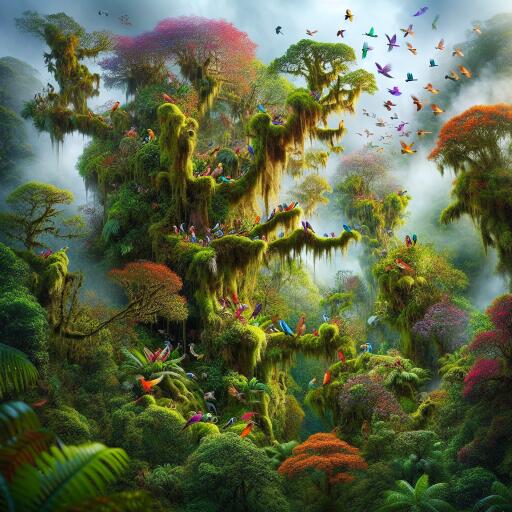
‘Unbelievable’ Renaissance of Rare Cloud Forest as Unique Species Reclaim Paradise
The air thick with mist clings to Mount Gower’s summit on Lord Howe Island, where ancient mosses and tree orchids flourish in a spectacle worthy of a fairy tale. This enigmatic cloud forest, shrouded in silence, unveils a hidden world of vibrant greens, rare palms, and gnarled trees cloaked in lichen.
Ascending to the island’s peak reveals an ethereal canopy, a reward for those who brave its rugged climb. Above, providence petrels soar, while below, in the cool shade, flightless Lord Howe Island woodhens weave through thick undergrowth.
Mount Gower and Mount Lidgbird, remnants of an ancient shield volcano, stand like sentinels at the island’s southern tip. Even on clear days, their peaks often pierce through self-born clouds as warm ocean breezes deterred by the mountains are coaxed to ascend, swiftly cooling to form a perpetual mist.
High above 750 meters, this fragile ecosystem is home to endemic flora and fauna found nowhere else on Earth. A “sky island” perched atop an earthly one, Lord Howe Island boasts an incredible 85% of plant species unique to its bounds, many restricted to the summit.
Officially known as the Gnarled Mossy Cloud Forest, this critically endangered ecosystem is a renowned biodiversity hotspot. Rodent invasions and climate changes posed significant threats in recent decades. However, a $15 million eradication initiative successfully purged the island of over 300,000 rodents, alongside non-native owls.
The rat eradication project aimed not merely at elimination but at safeguarding this delicate environment where their presence drove several species to extinction. Their removal initiated an impressive ecological resurgence, with more than 30 threatened flora and fauna species, including birds, insects, and snails, rebounding.
The renaissance didn’t go unnoticed by fifth-generation islander, Jack Shick, who’s climbed Mount Gower approximately 2,400 times, following in his family’s guiding footsteps. Each venture unveils a burgeoning transformation—palm seedlings now carpet the forest floor, thriving without rodent interference. The critically endangered tiny mountain palm thrives where it struggled before.
Bird and insect populations are likewise flourishing. Silver eyes, golden whistlers, and black-winged petrels are plentiful, indicative of an ecosystem thriving without the shadow of rodents and predator owls.
The summit offers sweeping vistas of the island, its coral lagoon shimmering below. Spectators on high can witness providence petrels who nest almost exclusively here, now safe from previous threats, their breeding success escalating from 2% to 50% in recent years.
One of the most compelling cues of recovery is the vibrant return of Lord Howe Island woodhens. Once at the brink of extinction, these cheeky birds are now thriving. Standing still, one hears their distinct calls punctuating the island’s unique symphony. From a mere 30 birds in the 1970s, their numbers have surged to over 2,000, owed largely to rodent eradication that allowed nearly year-round breeding.
In tandem with increased bird populations, the insect presence has markedly grown. Efforts revealed the reappearance of a weevil species presumed extinct since 1916. Additionally, endangered snail species, once scarce, are now regularly sighted, with new finds including several unknown species.
Lord Howe Island serves as an ideal platform for climate change research due to its mostly untouched ecosystem. Its relative isolation makes it perfect for observing environmental impacts, offering crucial insights that researchers translate into strategies addressing global environmental challenges.
The island’s pristine coral reef represents another critical indicator of climate change. Recent bleaching events echo the global struggle of corals adapting to rising ocean temperatures. Local observations reveal sporadic recovery, highlighting the persistent threats of a warming climate.
Enhanced by tropical, sub-tropical, and temperate currents, this unique marine system houses distinctive species, providing benchmarks for reef health. Temperature fluctuations, exacerbated by climate patterns, affect coral vitality, stressing the need for adaptive management and conservation efforts on global scales.
In striving for sustainability, the island’s residents prioritize environmental protection over economic gain, evident in local regulations and practices. Strict visitor limitations prevent overdevelopment, preserving the delicate ecological balance.
Strict biosecurity measures, involving sniffer dogs and comprehensive inspections of incoming goods and passengers, ensure the continued absence of invasive species. These efforts embody a community vigilant of their vital role in maintaining ecological integrity.
Visitors contribute to preservation endeavors through volunteer programs that combat invasive plant species. This collective commitment underscores a shared responsibility for safeguarding this unparalleled haven.
Lord Howe Island stands as a paragon of ecological stewardship, drawing on its unique biodiversity and spectacular landscapes to inspire current and future generations. As both a sanctuary and a beacon, this island offers hope and lessons in resilience against adversity.
Though challenges remain, the perseverance of local efforts ensures that this rarity among the world’s ecosystems will continue to flourish—a testament to the enduring bond between humans and nature.





Leave a Reply